

2024 Dodge Charger Daytona EV charges up next muscle car era
The 2024 Dodge Charger Daytona is not like other electric vehicles. The three- and five-door hatchback hurtles the performance brand into its electric future by embracing all the muscle car machismo of its past. As for range and efficiency—the typical pride points of an EV launch— Dodge CEO Tim Kuniskis was characteristically blunt: “I don’t care.”
“It’s not designed to get you 500 miles of range,” Kuniskis crowed to a media gathering last week before the global debut on Tuesday. “This is designed to be the ultimate performance car until we come out with the Banshee, of course.”
The Daytona Banshee will arrive last, late in 2025. The Charger Daytona BEVs go on sale this summer, and will be followed by the five-door variants early in 2025. At around the same time, Dodge will rock you with a Hurricane twin-turbo 3.0-liter inline-6 tuned to up to 550 hp in Charger Sixpack models. The new Charger effectively absorbs the Challenger two-door slot, even though Kuniskis says there are plans for the Challenger.
“We are gonna displace superchargers and replace them with kilowatts and Power Shots,” Kuniskis said about the Charger cadence as well as intimating future product that will include utility vehicles. “When we first started working on this platform, it was a very risky decision. The most efficient EV platform in the world is a skateboard. We made the decision at the time to do multi-energy to have multiple vehicles on that same platform.”

2024 Dodge Charger Daytona
2024 Dodge Charger Daytona range and performance
In spite of the performance posturing, the 2024 Charger Daytona still has an estimated 317 miles of range for the entry-level R/T model, while the Scat Pack scoots to 260 miles, courtesy of a 100.5-kwh (93.5-kwh usable) nickel-cobalt-aluminum lithium-ion battery pack.

2024 Dodge Charger Daytona
Utilizing the brand’s STLA Large platform, the Daytonas have two drive units with 250-kw permanent magnet synchronous motors, one for each axle for standard all-wheel drive. For the initial launch year, both the R/T and Scat Pack will come standard with a Direct Connection upgrade kit from Dodge’s performance parts arm that provides 15-second boosts of an extra 40 hp, as long as you allow 30 seconds between each boost. Dodge brands this the Power Shot, and it’s accessible via a steering wheel button opposite the drive mode button so you don’t have to fiddle with a toggle or touchscreen when you need more power. Next year, the Power Shot kits will cost extra.
The Stage 1 Power Shot on the R/T leads to a total output of 496 hp and 404 lb-ft of torque. Dodge estimates a 0-60 mph time of 4.7 seconds, a quarter-mile of 13.1 seconds, and a top speed of 137 mph.
The Stage 2 Power Shot juices the Scat Pack to 670 hp and 627 lb-ft. It specs out to a 0-60 mph time of 3.3 seconds, a quarter-mile of 11.5 seconds, and a top speed of 134 mph.
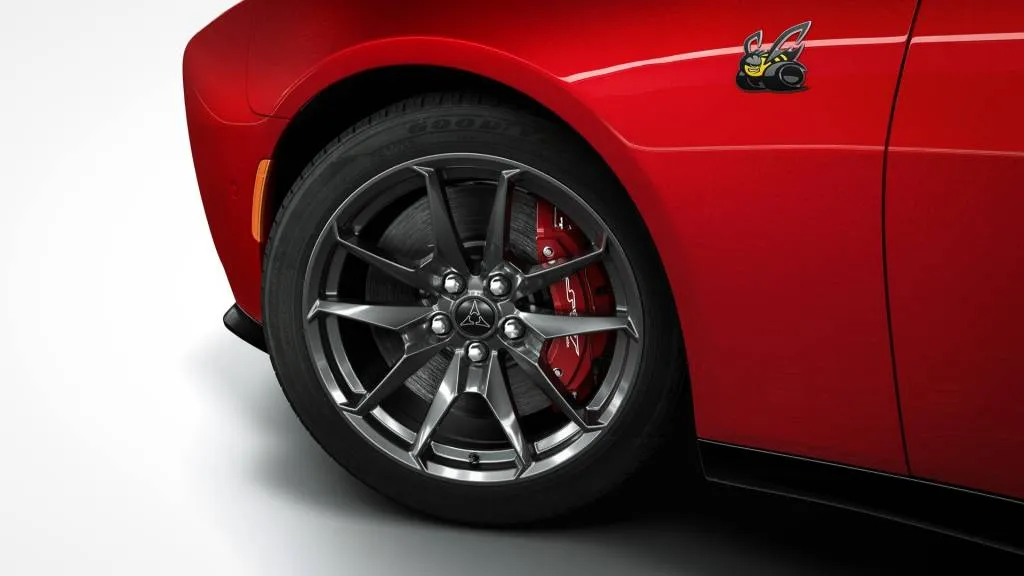
2024 Dodge Charger Daytona
Also standard for just the first year is the largest brake package ever offered on a Dodge, consisting of 6-piston Brembo front and 4-piston rear calipers clamping down on 16.0-inch rotors. One-pedal driving is not part of the plan, though paddle shifters enable three levels of regenerative braking.
The front drive unit disconnects power to the wheels and improves range and efficiency based on drive mode, while the rear unit has a mechanical limited-slip differential for better traction out of corners. Drive modes include the usual suspects, while Scat Packs get Drag, Drift, and Donut modes that cut or limit power to the front axle and neuter the traction control system.
A chambered Fratzonic exhaust that uses speakers under the body that are amplified through resonators, similar to a muffler resonator, or like a pipe organ. Inside it’s augmented by electronics and altogether makes what Dodge calls “Hellcat levels of sound.” It can be disabled via a stealth mode. It could even vibrate the car like a V-8, or it can be muted in stealth mode.
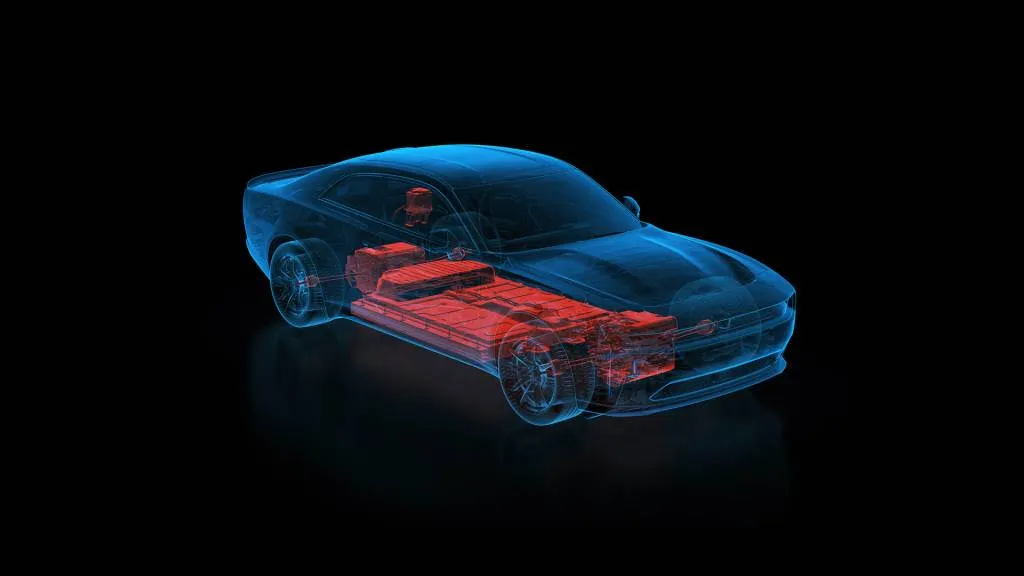
2024 Dodge Charger Daytona
The Scat Pack Track Package adds adaptive dampers to the multi-link front and rear suspension, and of course there’s a launch control function. Exclusive to the Scat Pack Track Package are staggered tires on the 20 inch wheels, with Goodyear Eagle F1 Supercar 3 305/35ZR20 up front on 11-inch wide wheels and 325s on 11.5-inch wide wheels in back.
The standard R/T wheels are 18 inches, but the EPA range estimate is based on the 20 inchers. Dodge did not provide a range estimate for 18-inch wheels.
The range and performance estimates are impressive considering one other spec: both Charger Daytonas weigh a whopping 5,838 pounds.
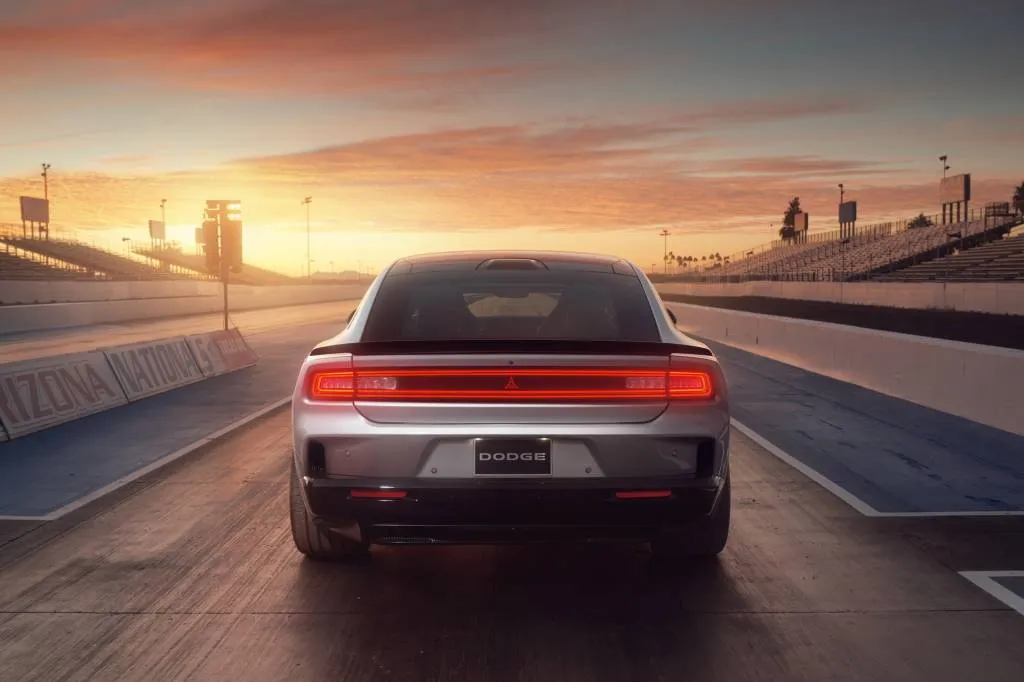
2024 Dodge Charger Daytona
Charger Daytona draws the EV muscle car
The 2024 Daytona looks nearly identical to the Dodge Charger Daytona SRT Concept unveiled in August 2022, with a nip and a tuck to appease regulators. At 206.6 inches, it’s half a foot longer than the outgoing Dodge Charger, but it’s wide enough for Dodge to call it the widest passenger car this side of a dually heavy duty truck.
The key characteristic feature of that concept and one that carries over with aerodynamic purpose is the R-Wing front blade topping the nose. Dodge didn’t tout the coefficient of drag, but the way the nose dives down reflects the almost platypus-like inspiration from the original 1968 Dodge Daytona Charger, which also had a 23-inch-tall wing at the rear. The R-Wing itself is “air neutral,” Dodge exterior designer Scott Krugger told Green Car Reports.
“By having [the nose] dive down, it’s 11 aero counts better [minus 0.011 to the coefficient of drag] than having a texture like a grille or breather that goes into an engine compartment.”
The wing helps give the Charger Daytona the brand’s trademark muscular presence. A front single light bar curls up at the edges to underscore the wing, stretching the fascia horizontally. The suggested line edges around the smooth sides into a body line that rises gracefully yet powerfully into the hatch. The 5.6-inch ground clearance and taller ride height are visually reduced with a black underbody that also rises up into the hatch beyond the rear wheels. Even though it’s an inch taller at 59.0 inches than the outgoing Charger, it still presents as wide and mean, and the sweeping C-pillars on the five-door model embodies those classic muscle car cues even more.
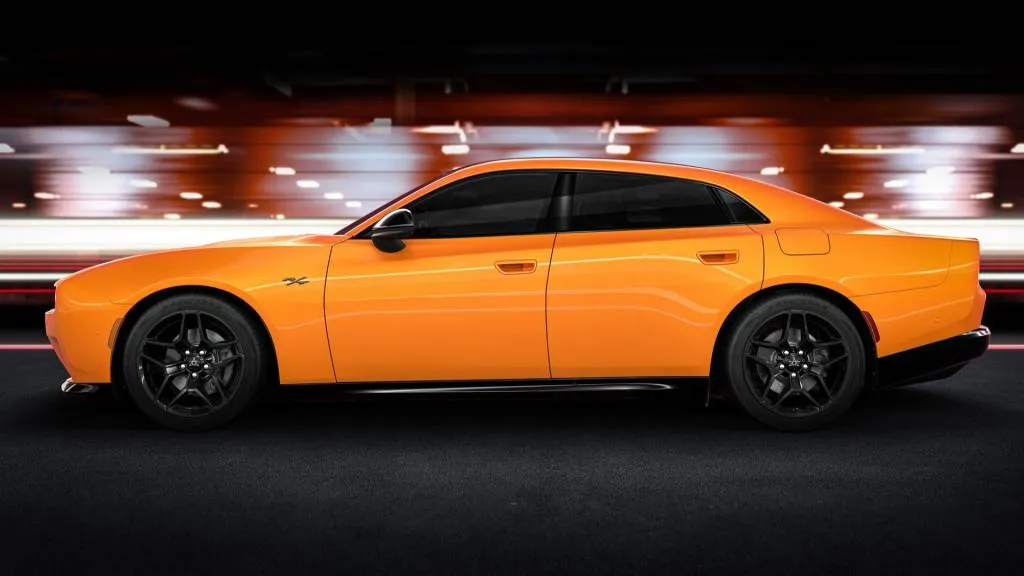
2024 Dodge Charger Daytona
Charger Daytona crosses over with a hatch
It’s a beautiful car, and it looks like no other EV on sale right now. We weren’t able to test the interior roominess of the five-door model, but the hatch opens up 133% more cargo room than in the outgoing Charger, Dodge says. There’s about 23 cubic feet of space, but even with the hidden floor it’s shallow, so if you want to fit the four track tires as Dodge promoted, you’ll have to flip down the 60:40-split rear seats that opens it up to 38.5 cubic feet of space.
That might be the best use of the rear seats for passengers above 6 feet tall, as the available fixed glass roof eats into headroom. Yet the 37.2 inches of legroom matches most compact crossovers, so four people could fit in comfort as long as the gangly folk go up front.
Also up front is a 1.5-cubic foot frunk to stow the charging cord.
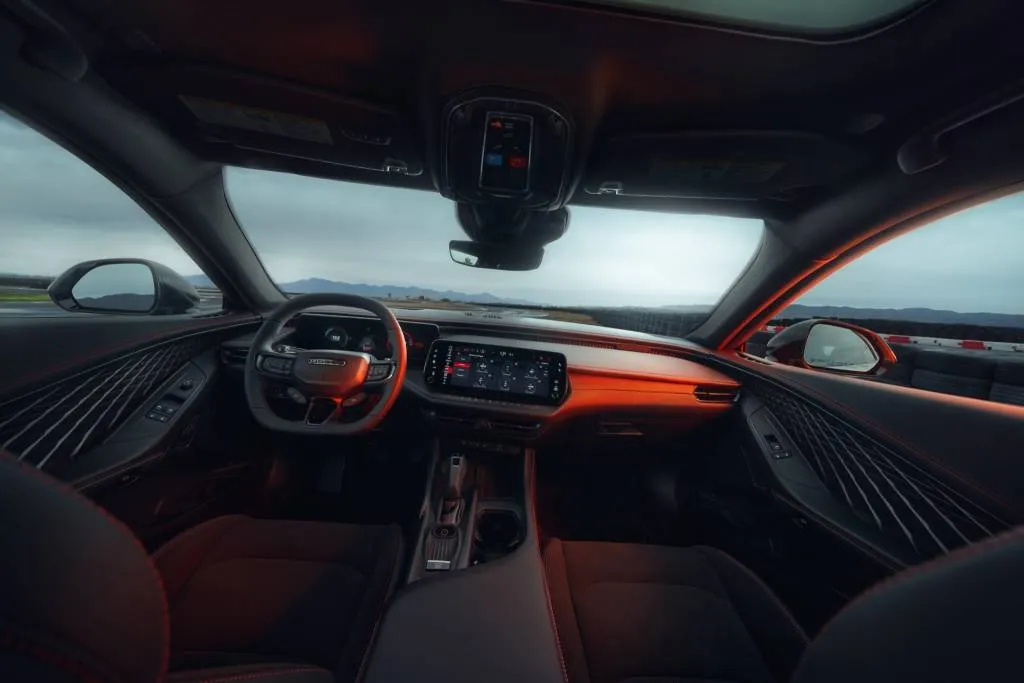
2024 Dodge Charger Daytona
The Dodge Charger Daytona charges at up to 183 kw
The 400-volt architecture supports a peak DC fast-charge rate of 183 kw, so on an available 350-kw DC charger the Daytona’s battery would charge from 20-80% in about 28 minutes. At home on a 240-volt connection, the Daytona’s 11-kw onboard charger fills the battery from 20-80% in 5.5 hours, or from 5-80% in about seven hours. Expect 10 hours for a full state of charge. Dodge will adapt the Tesla-derived NACS protocol in 2025.
Standard equipment includes a 10.3-inch digital instrument cluster (or an available 16.0-inch cluster) horizontally aligned with a 12.3-inch touchscreen with wireless Apple CarPlay and Android Auto, as well as a wireless smartphone charger. Standard driver-assist tech includes automatic emergency braking with pedestrian detection, active lane control, adaptive cruise control down to a stop, blind-spot monitors, and a driver-attention monitor.
When the 2024 Dodge Charger Daytonas go on sale this summer, we expect a price of about $55,000 for the R/T and less than $70,000 for the Scat Pack. Built in Windsor, Ontario, Canada, but with Samsung battery packs imported from Korea for the first year, the Charger Daytona won’t qualify for the federal EV tax credit on purchase, but it will for lease, according to Sam Abuelsamid, principal analyst for Guidehouse. Sometime in 2025, the Stellantis-Samsung joint venture plant in Kokomo, Ind. are planned to be producing the packs, and should qualify for the EV credit at purchase.
Add a comment Cancel reply
Comments (0)
Related posts


Electric SUVs: Top 6 Models for Family Trips











